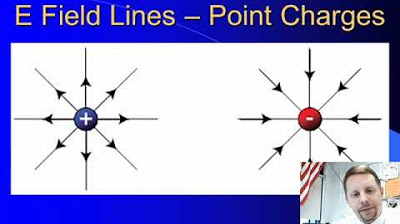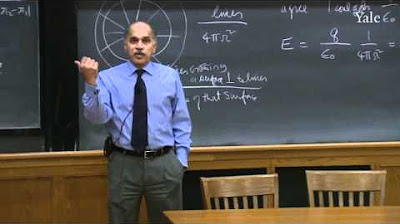(b) Deduce the behaviour of beams of protons, neutrons and electrons in an electric field
TLDRThis Einstein Academy video explores Learning Outcome B from the atomic structure topic in the GCE chemistry syllabus. It delves into the electrostatic force, explaining how it affects protons, neutrons, and electrons in an electric field. Protons and electrons are deflected towards oppositely charged plates due to their charges, while neutrons, being neutral, pass through unaffected. The video also discusses the factors influencing the strength of electrostatic forces and how the mass of particles influences their angle of deflection. It concludes with practical examples and mathematical relationships to solve related problems, aiming to clarify the behavior of charged particles in electric fields.
Takeaways
- 🧲 The electrostatic force is similar to magnetic force, where like charges repel and unlike charges attract.
- 🔋 The strength of the electrostatic force is influenced by the magnitude of the charges and the distance between them.
- 🚀 Protons, being positively charged, are attracted to the negatively charged plate in an electric field and repelled by the positive plate.
- ⚡ Electrons, negatively charged, are repelled by the negative plate and attracted to the positive plate in an electric field.
- 🏙 Neutrons, being electrically neutral, pass straight through an electric field without being attracted or repelled.
- ⚖️ The angle of deflection of a particle in an electric field is related to the charge-to-mass ratio, with electrons deflecting more due to their smaller mass compared to protons.
- 📚 The angle of deflection can be calculated using the formula involving the charge, mass, and a proportionality constant.
- 🔍 The charge-to-mass ratio (Q/m) is a key factor in determining how particles behave when subjected to an electric field.
- 📉 The larger the mass of a particle, the smaller the angle of deflection for a given charge.
- 🔄 The behavior of particles in an electric field can be used to solve problems involving unknown charges or masses by using the proportionality constant.
- 📝 The script provides a step-by-step explanation of how to use the mathematical relationship to solve A-Level chemistry questions related to particle deflection in electric fields.
Q & A
What is the main topic of the video from Einstein Academy?
-The main topic of the video is learning outcome B from the topic of atomic structure, focusing on the behavior of beams of protons, neutrons, and electrons in an electric field.
What is the electrostatic force?
-The electrostatic force is the force of attraction or repulsion between charged particles, similar to the behavior of magnets where unlike charges attract and like charges repel.
How does the magnitude of charges affect the strength of the electrostatic force?
-The larger the magnitude of the charges, the stronger the force of attraction or repulsion between the particles.
How does distance between charges affect the electrostatic force?
-The closer the two charges are to one another, the stronger the force of attraction or repulsion between them.
How do protons behave when passed through an electric field?
-Protons, being positively charged, are attracted to the negative plate and repelled by the positive plate in an electric field, causing them to be deflected towards the negative plate.
What is the behavior of electrons in an electric field?
-Electrons, being negatively charged, are repelled by the negative plate and attracted to the positive plate, resulting in their deflection towards the positive plate.
How do neutrons behave in an electric field?
-Neutrons are electrically neutral, so they are neither attracted nor repelled by the plates and pass straight through the electric field.
Why is the deflection angle of electrons greater than that of protons?
-The deflection angle of electrons is greater than that of protons because electrons have a much smaller mass compared to protons.
How is the angle of deflection related to charge and mass?
-The angle of deflection is proportional to the charge over mass ratio. Higher charge or lower mass results in a greater deflection angle.
What mathematical relationship is used to calculate the angle of deflection?
-The angle of deflection (θ) can be calculated using the formula θ = k * (Q/m), where k is the proportionality constant, Q is the charge, and m is the mass.
How can the proportionality constant (k) be determined?
-The proportionality constant (k) can be determined using a test case with known values of angle, charge, and mass. For example, if protons are deflected by an angle of 15 degrees, k can be calculated using the charge and mass of the proton.
How do you use the formula θ = k * (Q/m) to solve for unknown variables?
-Given any two out of the three variables (angle, charge, mass), you can solve for the third variable using the formula. For instance, given the angle and mass, you can solve for the charge.
What is the charge and deflection angle for deuterium in the given example?
-For deuterium (D-), with a charge of -1 and a mass of 2, the deflection angle is -7.5 degrees, indicating deflection towards the positive plate.
What is the charge and deflection angle for tritium in the given example?
-For tritium (T+), with a charge of +1 and a mass of 3, the deflection angle is +5 degrees, indicating deflection towards the negative plate.
What is the charge and deflection angle for a helium-2+ particle in the given example?
-For a helium-2+ particle, with a charge of +2 and a mass of 4, the deflection angle is +0.5 degrees.
How do you determine the charge of a particle given the deflection angle and mass?
-Given the deflection angle and mass, you can solve for the charge using the formula θ = k * (Q/m). For example, if a particle with 12 times the mass of a proton is deflected by 5 degrees, the charge can be calculated as +4.
How do you determine the number of protons, neutrons, and electrons in a particle?
-Given the total charge and mass, you can calculate the number of protons, neutrons, and electrons. For example, a particle with 6 protons, a charge of +4, and a mass of 12 has 6 protons, 2 electrons (6 protons - 4 charge), and 6 neutrons (12 mass - 6 protons).
Outlines
🔍 Introduction to Electrostatic Force and Particle Behavior in Electric Fields
The video starts with an introduction to the topic of electrostatic forces and their role in understanding atomic structure, as part of the chemistry syllabus. It explains the basic principles of electrostatic forces, comparing them to magnetic forces, and emphasizes the attraction between opposite charges and repulsion between like charges. The strength of these forces depends on the magnitude of the charges and the distance between them. The section also explains the behavior of protons, neutrons, and electrons when exposed to an electric field, highlighting how protons are deflected towards the negative plate, electrons towards the positive plate, and neutrons pass straight through due to their neutrality.
📐 Proportionality of Charge and Mass Ratio to Deflection Angle
This section delves into the mathematical relationship between the angle of deflection of particles in an electric field and their charge-to-mass ratio. It explains how the angle of deflection is directly proportional to the charge and inversely proportional to the mass of the particles. The concept is illustrated with examples, comparing particles with different charges and masses. The section also introduces the proportionality constant (K) and demonstrates how to use this constant to solve problems related to the deflection of particles. It emphasizes the importance of understanding this relationship for solving A-level exam questions.
📊 Applying Mathematical Relationships to Solve Questions
The final section of the video provides a step-by-step approach to applying the mathematical relationships discussed earlier to solve specific exam questions. It includes detailed examples from past A-level exams, showing how to calculate the angle of deflection for various particles given their charge and mass. The section also covers how to determine the charge on a particle when given its deflection angle and mass. The video concludes by summarizing the key learning outcome: understanding the behavior of beams of protons, neutrons, and electrons in an electric field and using mathematical relationships to solve related problems. Viewers are encouraged to practice these concepts and subscribe for more educational videos.
Mindmap
Keywords
💡Electrostatic Force
💡Charge
💡Protons
💡Neutrons
💡Electrons
💡Electric Field
💡Deflection
💡Mass
💡Charge-to-Mass Ratio
💡Proportionality Constant
💡Deuterium and Tritium
Highlights
The video discusses learning outcome B from the atomic structure topic in the chemistry syllabus, focusing on the behavior of protons, neutrons, and electrons in an electric field.
Electrostatic force is introduced as a fundamental concept, similar to magnetic forces, with like charges repelling and unlike charges attracting each other.
Factors affecting the strength of electrostatic forces, such as the magnitude of charges and the distance between charges, are explained.
The behavior of protons, neutrons, and electrons in an electric field is detailed, with protons being attracted to the negative plate and repelled by the positive plate.
Electrons, being negatively charged, are repelled by the negative plate and attracted to the positive plate, resulting in deflection towards the positive plate.
Neutrons, being electrically neutral, pass straight through the electric field without being attracted or repelled.
The difference in mass between protons and electrons affects the angle of deflection, with electrons being deflected more due to their smaller mass.
An example question from the November 2012 A-level paper is used to illustrate the differences in behavior between protons and electrons in an electric field.
The angle of deflection is mathematically related to the charge-to-mass ratio, with a formula provided to calculate it.
The formula for angle deflection is explained, showing it is proportional to the charge and inversely proportional to the mass.
A step-by-step guide on how to use the angle deflection formula to solve for unknown variables in given scenarios is provided.
A specific example from the November 2012 paper is worked through to demonstrate the application of the angle deflection formula.
The video concludes with a comprehensive explanation of how to solve for the charge on a particle given its mass and deflection angle.
The learning outcome is restated to emphasize understanding the behavior of charged particles in an electric field and the mathematical relationships involved.
The video encourages viewers to like and subscribe for more learning outcomes from the atomic structure chemistry syllabus.
Transcripts
Browse More Related Video

High School Physics - Electric Fields

(a) Protons, neutrons and electrons in terms of their relative charges and masses

2. Electric Fields

Coulomb's Law - Net Electric Force & Point Charges

Protons, Neutrons and Electrons Explained - what's the difference?

What's Inside an Atom? Protons, Electrons, and Neutrons!
5.0 / 5 (0 votes)
Thanks for rating: